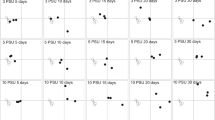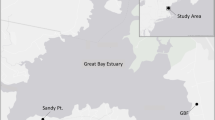Abstract
We examined the contrasting, effects of floods and droughts produced by large changes in local climatology on vegetation patterns in Nueces marsh, a semi-arid subtropical salt marsh in south Texas from 1995 to 2005. Climate variations during the study included an initial 4-yr period of moderate conditions, followed by a 2-yr interval of drought, and a recent 4-yr wet period that included large-scale floods. Variation in freshwater inflow, rainfall, and potential evapotranspiration were used in conjunction with field measurements of salinity, inorganic nitrogen, and vegetation structure collected at sites located at varying distances from Nueces Bay. Tidal creek salinities varied with Nueces Bay salinity, with strength of effect inversely related to distance from the bay. Mean (±standard deviation) pore water salinities ranged from 59±54‰ at two high, marsh stations farthest from the bay (10.1 km distant) to 30±21‰ in soil at a low marsh site closest to the bay (0.5 km distant). Mean pore water ammonium was also higher at stations most distant from the bay; nitrate + nitrite did not exhibit a high marsh to low marsh gradient. Nueces Bay salinity decreased substantially when the 10-d cumulative mean daily Nueces River flows exceeded 10 m3 s−1. During periods of low and moderate flood frequency (flows mostly below 10 m3 s−1), vegetation assemblages were dominated by stress-tolerant clonal plants. A catastrophic flood, which immersed vegetation for several weeks between July and September 2002, resulted in extensive plant mortality, but within months, unvegetated areas were rapidly colonized by the obligate annualSalicornia bigelovii. With the end of major flooding by late 2004, plant community structure began a return to pre-drought assemblages at high and middle marsh stations by summer 2005. At the low marsh station, new conditions favored clonal dominants (Spartina alterniflora andBorrichia frutescens), with the latter replacingSalicornia virginica as the dominant species. Our results support the theory that the importance of competition and abiotic stress in determining community composition are inversely related.
Similar content being viewed by others
Literature Cited
Adam, P. 1990. Salt Marsh Ecology. Cambridge University Press, Cambridge, U.K.
Alexander, H. D. andK. H. Dunton. 2002. Freshwater inundation effects on emergent vegetation of a hypersaline salt marsh.Estuaries 25:1426–1435.
Alexander, H. D. andK. H. Dunton. 2006. Treated wastewater effluent as an alternative freshwater source in a hypersaline salt marsh: Impacts on salinity, inorganic nitrogen, and emergent vegetation.Journal of Coastal Research 22:377–392.
Allison, S. K. 1996. Recruitment and establishment of salt marsh plants following disturbance by flooding.American Midland Naturalist 136:232–247.
Baldwin, A. H. andI. A. Mendelssohn. 1998. Effects of salinity and water level on coastal marshes: An experimental test of disturbance as a catalyst for vegetation change.Aquatic Botany 61:255–268.
Begon, M., J. L. Harper, andC. R. Townsend. 1990. Ecology: Individuals, Populations and Communities, 2nd edition. Blackwell Scientific Publishing, Malden, Massachusetts.
Bertness, M. D. 1991. Zonation ofSpartina patens andSpartina alterniflora in a New England salt marsh.Ecology 72:138–148.
Bertness, M. D., andR. Callaway. 1994. Positive interactions in communities.Trends in Ecology and Evolution 9:191–193.
Bertness, M. D., andA. M. Ellison. 1987. Determinants of pattern in a New England salt marsh plant community.Ecological Monographs 57:129–147.
Bertness, M. D., L. Gough, andS. W. Shumway. 1992. Salt tolerances and the distribution of plants across a New England salt marsh.Ecology 72:1842–1851.
Bertness, M. D., andS. C. Pennings. 2000. Spatial variation in process and pattern in salt marsh plant communities in eastern North America, p. 39–57.In P. Weinstein and D. A. Kreeger (eds.), Concepts and Controversies in Tidal Marsh Ecology. Kluwer Academic Publishing, Dortrecht, The Netherlands.
Boutin, C. andP. A. Keddy. 1993. A functional classification of wetland plants.Journal of Vegetation Science 4:591–600.
Brock, D. A. 2001. Nitrogen budget for low and high freshwater inflows, Nueces Estuary, Texas.Estuaries 24:509–521.
Bureau of Reclamation. 2000. Concluding Report: Rincon Bayou Demonstration Project, Volume II. Findings. U.S. Department of the Interior, Bureau of Reclamation, Oklahoma-Texas Area Office, Austin, Texas.
Buresh, R. J., R. D. Delaune, andW. H. Patrick, Jr. 1980. Nitrogen and phosphorus distribution and utilization bySpartina alterniflora in a Louisiana Gulf Coast marsh.Estuaries 3:111–121.
Chapman, V. J. 1974. Salt Marshes and Salt Deserts of the World, 2nd edition, J. Cramer, Lehre, Germany.
Clarke, K. R. andR. M. Warwick. 2001. Change in Marine Communities: An Approach to Statistical Analysis and Interpretation, 2nd edition. Primer-E: Plymouth, Plymouth, U.K.
Day, R. T., P. A. Keddy, J. McNeill, andT. Carleton. 1988. Fertility and disturbance gradients: A summary model for riverine marsh vegetation.Ecology 69:1044–1054.
Diaz, S. andM. Cabido. 1997. Plant functional types and ecosystem function in relation to global change.Journal of Vegetation Science 8:463–474.
Dunton, K. H., B. Hardegree, andT. E. Whiteledge. 2001. Response of estuarine marsh vegetation to interannual variations in precipitation.Estuaries 24:851–861.
Ellison, A. M. 1987. Effects of competition, disturbance, and herbivory onSalicornia europaea.Ecology 68:576–586.
Godfrey, R. K. andJ. W. Wooten. 1979. Aquatic and Wetland Plants of Southeastern United States. The University of Georgia Press, Athens, Georgia.
Gough, L., J. B. Grace, andK. L. Taylor. 1994. The relationship between species richness and community biomass: The importance of enviromental variables.Oikos 70:217–279.
Grace, J. B. andB. H. Pugesek. 1997. A structural equation model of plant species richness and its application to a coastal wetland.The American Naturalist 149:436–460.
Greiner La Peyre, M. K., J. B. Grace, E. Hahn, andI. A. Mendelssohn. 2001. The importance of competition in regulating plant species abundance along a salinity gradient.Ecology 82:62–69.
Grime J. P. 1974. Vegetation classification by reference to strategies.Nature 250:26–31.
Grime, J. P. 1979. Evidence for the existence of three primary strategies in plants and its relevance to ecological and evolutionary theory.The American Naturalist 111:1169–1194.
Gunderson, L. H. 2000. Ecological resilience—In theory and application.Annual Review Ecological Systems 31:425–439.
Heinsch, F. A., J. L. Heilman, K. J. McInnes, D. R. Cobos, D. A. Zuberer, andD. L. Roelke. 2004. Carbon dioxide exchange in a high marsh on the Texas Gulf Coast: Effects of freshwater availability.Agricultural and Forest Meterology 125:159–172.
Henningson, Durham and Richardson, Inc. 1979. Phase 3 Final Report, Volume 1, Additional Studies on Freshwater Needs of Fish and Wildlife Resources in Nueces-Corpus Christi Bay area, Texas. Technical Report to U.S. Fish and Wildlife Service, Austin, Texas.
Keddy, P. A. 2000. Wetland Ecology Principles and Conservation. Cambridge University Press, U.K.
Keer, G. H. andJ. B. Zedler. 2002. Salt marsh canopy architecture differs with the number and composition of species.Ecological Applications 12:456–473.
Keiffer, C. H. andI. A. Ungar. 1997. The effect of extended exposure to hypersaline conditions on the germination of five inland halophyte species.American Journal of Botany 84:104–111.
Mitsch, W. J. andJ. G. Gosselink. 2000. Wetlands. John Wiley and Sons, Inc., New York.
Montagna, P. A., S. A. Holt, C. Ritter, S. Herzka, K. F. Binney, andK. H. Dunton. 1998. Characterization of Anthropogenic and Natural Disturbance on Vegetated and Unvegetated Bay Bottom Habitats in the Corpus Christi Bay National Estuary Program Study Area, Volume I. Literature Review. Publication CCBNEP-25A, Texas Natural Resource Conservation Commission. Austin, Texas.
Nomann, B. E. andS. C. Pennings. 1998. Fiddler crab-vegetation interactions in hypersaline habitats.Journal of Experimental Marine Biology and Ecology 225:53–68.
Parsons, T. R., Y. Maita, andC. M. Lalli. 1984. A Manual of Chemical and Biological Methods for Seawater Analysis. Pergamon Press, New York.
Pennings, S. C. andR. M. Callaway. 1992. Salt marsh plant zonation: The relative importance of competition and physical factors.Ecology 73:681–690.
Pugnaire, F. I., P. Haas, andJ. Puigdefabregas. 1996. Facilitation between higher plant species in a semiarid environment.Ecology 77:1420–1426.
Raffaelli, D. andS. Hawkins. 1996. Intertidal Ecology. Chapman and Hall, London.
Redondo, S., A. E. Rubio-Casal, J. M. Castillo, C. J. Luque, A. A. Alvarez, T. Luque, andM. E. Figueroa. 2004. Influences of salinity and light on germination of threeSarcocornia taxa with contrasted habitats.Aquatic Botany 78:255–264.
Rosenberry, D. O., D. I. Stannard, T. C. Winter, andM. L. Martinez. 2004. Comparison of 13 equations for determining evapotranspiration from a prairie wetland, Cottonwood Lake area, North Dakota, USA.Wetlands 24:483–497.
Shumway, S. W. andM. D. Bertness. 1992. Salt stress limitation of seedling recruitment in a salt-marsh plant community.Oecologia 92:490–497.
Twilley, R., E. J. Barron, H. L. Gholz, M. A. Harwell, R. L. Miller, D. J. Reed, J. B. Rose, E. H. Siemann, R. G. Wetzel, andR. J. Zimmerman. 2001. Confronting Climate Change in the Gulf Coast Region: Prospects for Sustaining Our Ecological Heritage. Union of Concerned Scientists, Cambridge, Massachusetts: and Ecological Society of America. Washington, D.C.
Walker, B. 1995. Conserving biological diversity through ecosystem resilience.Conservation Biology 9:747–752.
Ward, G. andN. Armstrong. 1997. Ambient Water, Sediment and Tissue Quality of Corpus Christi Bay Study Area, Present Status and Historical Trends. Summary Report CCBNEP-13, Corpus Christi Bay National Estuary Program, Corpus Christi, Texas.
Ward, G. H., M. J. Irlbeck, andP. A. Montagna. 2002. Experimental river diversion for marsh enhancement.Estuaries 25:1416–1425.
Ward, G. H. andM. J. Irlbeck. 2000. Hydrography, p. 3-1–3-24.In R. G. Harris (ed.), Concluding Report: Rincon Bayou Demonstration Project, Volume II. Findings. U.S. Department of the Interior, Bureau of Reclamation, Austin, Texas.
Ward, Jr.,G. H. 1985. Marsh enhancement by freshwater diversion.Journal of Water Resources Planning and Management 111:1–23.
Weilhoefer, C. L. 1998. Effects of freshwater inflow, salinity and nutrients on salt marsh vegetation in South Texas, M.S. Thesis. University of Texas at Austin, Austin, Texas.
Zedler, J. B. andP. A. Beare. 1986. Temporal variability of salt marsh vegetation: The role of low-salinity gaps and environmental stress, p. 295–303.In D. A. Wolfe (ed.), Estuarine Variability. Academic Press, Inc., Orlando, Florida.
Zedler, J. B., J. C. Callaway, J. S. Desmond, G. Vivian-Smith, G. D. Williams, G. Sullivan, A. E. Brewster, andB. K. Bradshaw. 1999. California salt marsh vegetation: An improved model of spatial pattern.Ecosystems 2:19–35.
Zedler, J. B., J. Covin, C. Nordby, P. Williams, andJ. Boland. 1986. Catastrophic events reveal the dynamic nature of salt-marsh vegetation in southern California.Estuaries 91:75–80.
Zedler, J. B., H. Morzaria-Luna, andK. Ward. 2003. The challenge of restoring vegetation on tidal, hypersaline substrates.Plant and Soil 253:259–273.
Zedler, J. B. andC. P. Onuf. 1984. Biological and physical filtering in arid-region estuaries: Seasonality, extreme events, and effects of watershed modification. p. 415–432.In V. S. Kennedy (ed.), The Estuary as a Filter. Academic Press, Orlando, Florida.
Sources of Unpublished Materials
Division of Nearshore Research. 2005. Nueces Bay Salinity Monitoring, Center for Coastal Studies, Texas A&M University, Corpus Christi, Texas, accessed August 2005 at http:// lighthouse.tamucc.edu/pquery.
National Climate Data Center. 2005. Unedited Local Climatological Data, accessed August 2005 from http://cdo.ncdc.noaa. gov/ulcd/ULCD.
USGS,Water Resources 2005. Real-Time Water Data for Texas, Station 08211500, accessed August 2005, http://waterdata.usgs. gov/tx/nwis/uv?.
Author information
Authors and Affiliations
Corresponding author
Rights and permissions
About this article
Cite this article
Forbes, M.G., Dunton, K.H. Response of a subtropical estuarine marsh to local climatic change in the southwestern Gulf of Mexico. Estuaries and Coasts: J ERF 29, 1242–1254 (2006). https://doi.org/10.1007/BF02781824
Received:
Revised:
Accepted:
Issue Date:
DOI: https://doi.org/10.1007/BF02781824




